Quick Answer: Best Pranayama For High Blood Pressure:
Among the various pranayama techniques, the most effective for high blood pressure management are Anulom Vilom, Bhramari, Shitali, Shitkari, Udgeeth, Chandra Bhedana, Nadi Shodhana, and Ujjayi. These practices, when performed mindfully and under guidance, can help reduce stress, improve circulation, and promote relaxation, contributing to better blood pressure control.
Table of Contents
Introduction:
High blood pressure, known as hypertension, is a common yet serious health concern. In addition to conventional treatments and lifestyle changes, pranayama, a practice rooted in yoga, offers potential benefits for managing this condition. This controlled breathing technique has been studied for its ability to reduce stress, enhance circulation, and promote relaxation, which can contribute to lower blood pressure. In this article, we delve into specific pranayama techniques that may complement traditional hypertension management strategies, emphasizing the importance of guidance from qualified instructors and consultation with healthcare professionals.
Pranayam for High BP
Pranayama is a set of yogic breathing exercises that can help manage high blood pressure when practiced regularly and correctly. Each pranayama technique has its own benefits and steps. Here’s a detailed explanation of each of the pranayama techniques:
1. Anulom Vilom (Alternate Nostril Breathing):
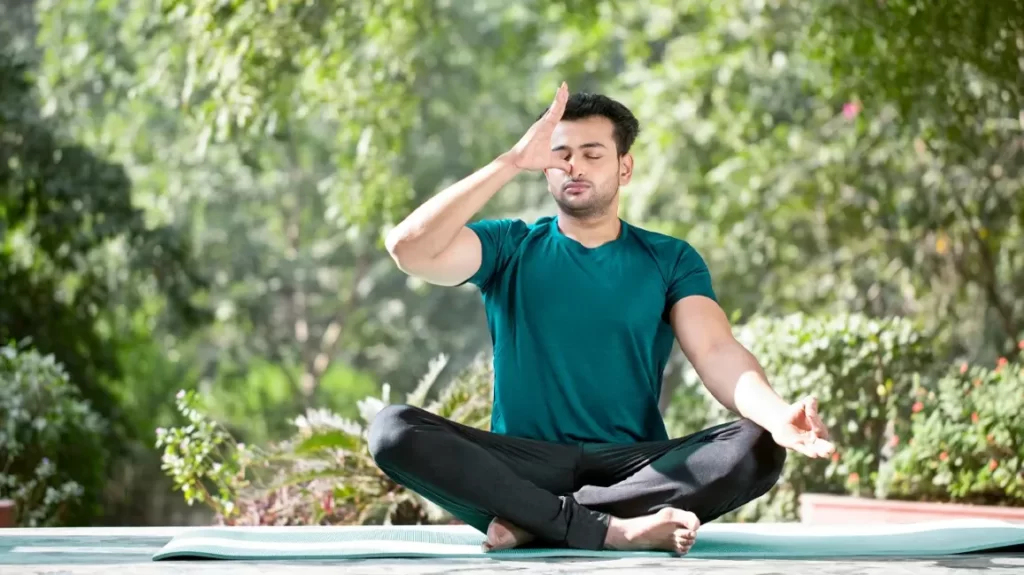
Steps:
- Sit comfortably with your back straight and shoulders relaxed.
- Close your eyes and take a few deep breaths to relax.
- Use your right thumb to gently close your right nostril.
- Inhale slowly and deeply through your left nostril, counting to four as you breathe in.
- Close your left nostril with your right ring finger, simultaneously releasing the right nostril.
- Exhale slowly and completely through your right nostril, counting to eight as you breathe out.
- Inhale deeply through the right nostril for a count of four.
- Close the right nostril again and release the left.
- Exhale through the left nostril for a count of eight.
- This completes one round. Continue for 5-10 minutes.
Effects:
- Anulom Vilom balances the activity of the left and right hemispheres of the brain.
- It reduces stress, lowers heart rate, and regulates blood pressure.
- The extended exhalation helps release carbon dioxide, which aids in relaxation.
2. Bhramari (Bee Breath):

Steps:
- Sit comfortably with your back straight and close your eyes.
- Place your index fingers on your ears’ cartilage, covering your ear holes.
- Inhale deeply through your nose.
- Exhale slowly and gently while making a humming sound similar to a bee.
- Focus on the vibration and resonance of the sound within your head.
Effects:
- Bhramari is an excellent stress reliever and calms the mind.
- It stimulates the parasympathetic nervous system, reducing blood pressure and promoting relaxation.
- Regular practice can improve concentration and memory.
3. Shitali (Cooling Breath):
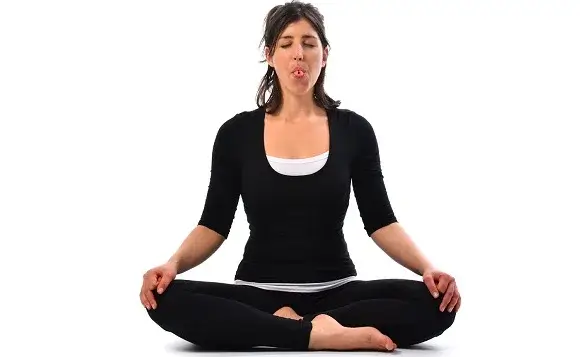
Steps:
- Sit comfortably with your spine straight.
- Roll your tongue into a tube shape or purse your lips if tongue rolling is difficult.
- Inhale slowly and deeply through the rolled tongue (or pursed lips).
- Close your mouth and exhale through your nose.
- Repeat this process for several breaths.
Effects:
- Shitali cools the body and mind, making it beneficial for reducing high blood pressure caused by stress or heat.
- It soothes the nervous system, promoting relaxation and mental clarity.
4. Sheetkari (Hissing Breath):
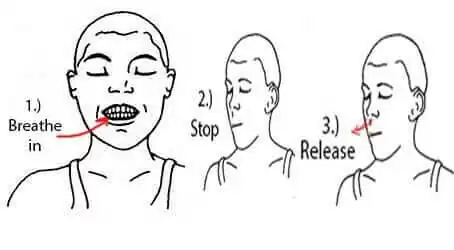
Steps:
- Sit comfortably with your spine straight.
- Close your eyes and relax.
- Gently press your upper and lower teeth together and separate your lips.
- Inhale slowly and deeply through the gaps between your teeth, creating a hissing sound.
- Close your mouth and exhale through your nose.
Effects:
- Sheetkari has a cooling effect on the body and mind.
- It reduces stress and anxiety, potentially contributing to lower blood pressure over time.
5. Udgeeth (Omkar Chanting):

Steps:
- Sit comfortably with your eyes closed.
- Inhale deeply through your nose.
- Exhale slowly while chanting the sound “Om” (AUM).
- Allow the sound to resonate within you.
- Inhale and repeat the chant.
Effects:
- Udgeeth is deeply meditative and can calm the mind and nervous system.
- It may help reduce stress and indirectly lower blood pressure by promoting relaxation.
6. Chandra Bhedana (Left Nostril Breathing):
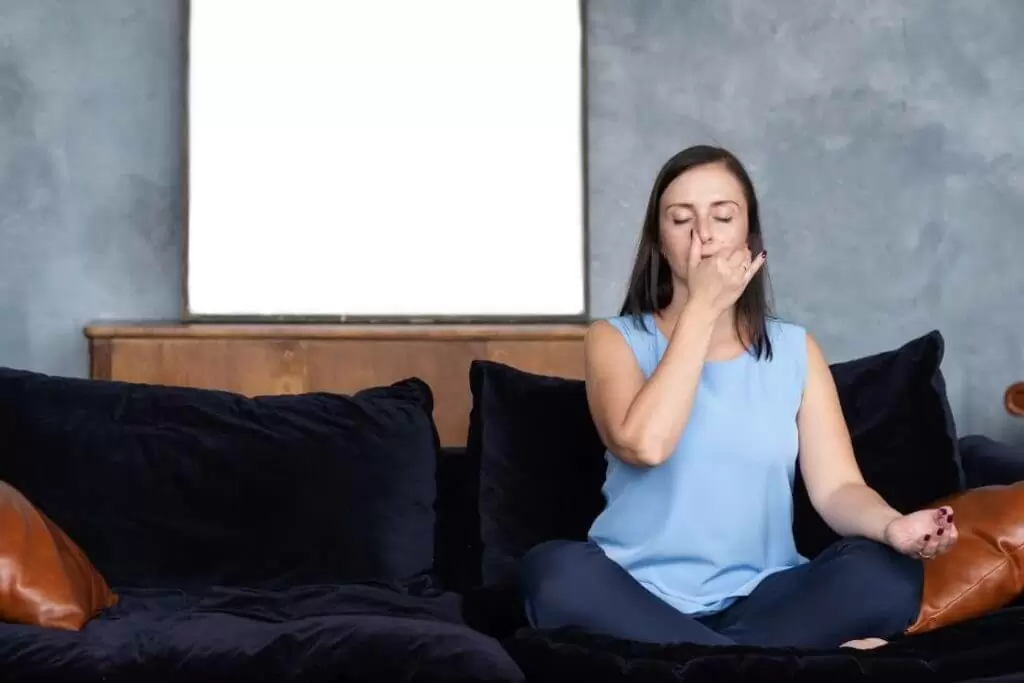
Steps:
Sit with your spine straight.
Close your right nostril with your right thumb.
Inhale deeply through your left nostril.
Close your left nostril with your right ring finger.
Release your right nostril and exhale slowly through it.
Inhale deeply through your right nostril.
Close the right nostril and release the left.
Exhale through the left nostril.
This completes one cycle. Repeat for 5-10 minutes.
Effects:
- Chandra Bhedana is calming and cooling.
- It reduces stress and anxiety, potentially lowering blood pressure over time.
7. Nadi Shodhana (Alternate Nostril Breathing):

Steps:
- Sit with your spine straight.
- Close your eyes and relax.
- Use your right thumb to close your right nostril.
- Inhale through your left nostril.
- Close your left nostril with your right ring finger.
- Release your right nostril and exhale through it.
- Inhale through the right nostril.
- Close the right nostril and release the left.
- Exhale through the left nostril.
- This completes one cycle. Repeat for 5-10 minutes.
Effects:
- Nadi Shodhana balances energy channels.
- It calms the mind and reduces stress, potentially regulating blood pressure.
- Improves concentration and mental clarity.
8. Ujjayi Pranayama (Victorious Breath):
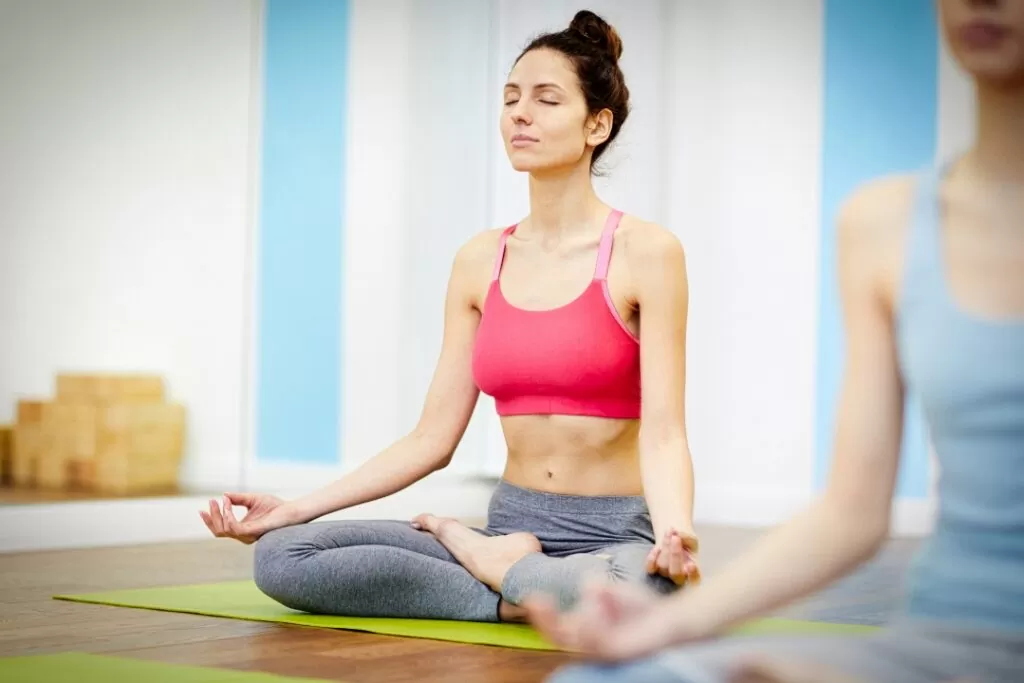
Steps:
- Sit comfortably.
- Inhale deeply through your nose.
- Constrict the back of your throat, creating a hissing sound as you exhale through your nose.
- Maintain this slight constriction during both inhalation and exhalation.
- Focus on the sound of your breath, like ocean waves.
Effects:
- Ujjayi enhances concentration and mindfulness.
- It reduces stress and tension, potentially aiding in lowering blood pressure.
- The sound of Ujjayi breath can help anchor your attention during meditation.
How Does Pranayama Help in Lowering High Blood Pressure?
Pranayama, the practice of controlled yogic breathing, can help lower high blood pressure (hypertension) through several mechanisms:
- Stress Reduction: One of the primary causes of high blood pressure is chronic stress. Pranayama techniques promote relaxation and reduce stress by activating the parasympathetic nervous system, also known as the “rest and digest” system. When the body is in a state of relaxation, blood vessels dilate, and blood pressure tends to decrease.
- Improved Blood Circulation: Pranayama practices enhance blood circulation, ensuring that oxygen and nutrients are efficiently delivered to various organs and tissues. Improved circulation reduces the resistance against blood flow in the arteries, which can contribute to lower blood pressure.
- Enhanced Oxygenation: Many pranayama techniques involve deep and controlled breathing patterns. This increases the oxygen levels in the bloodstream, improving the oxygen supply to the heart and reducing the workload on the heart muscle. When the heart works more efficiently, it can help regulate blood pressure.
- Balancing the Autonomic Nervous System: Pranayama exercises like Anulom Vilom and Nadi Shodhana help balance the autonomic nervous system, which controls involuntary bodily functions like heart rate and blood pressure. By regulating the autonomic nervous system, pranayama can help maintain healthy blood pressure levels.
- Strengthening Respiratory Muscles: Certain pranayama practices, such as Kapalabhati, strengthen the diaphragm and other respiratory muscles. This improved respiratory function can reduce the effort required for breathing, leading to lower blood pressure.
- Reduction in Anxiety and Depression: Pranayama has been shown to alleviate symptoms of anxiety and depression. These mental health benefits can indirectly lead to lower blood pressure, as chronic anxiety and depression are often associated with hypertension.
- Promotion of Mindfulness: Practicing pranayama requires concentration and mindfulness. Regular practice can enhance self-awareness and self-regulation, allowing individuals to better manage their stress responses, which can contribute to lower blood pressure.
It’s important to note that while pranayama can be a valuable adjunct in managing high blood pressure, it should not replace medical treatment or advice from a healthcare professional.
Which Pranayama Is Not Good For High Blood Pressure?
While pranayama can be beneficial for managing high blood pressure, some techniques may not be suitable for individuals with uncontrolled hypertension or certain medical conditions. Pranayama practices that involve forceful or rapid breathing, such as Bhastrika and Kapalabhati, should be approached with caution or avoided if you have high blood pressure that is not well-controlled. Here’s why:
- Bhastrika Pranayama (Bellows Breath): This technique involves rapid and forceful inhalations and exhalations through the nose. While it can be invigorating and energizing, it may also temporarily raise blood pressure due to forceful breathing. People with uncontrolled high blood pressure or certain cardiovascular conditions should avoid Bhastrika or practice it very gently under the guidance of an experienced instructor.
- Kapalabhati Pranayama (Skull Shining Breath): Kapalabhati involves rapid and forceful exhalations with passive inhalations. Similar to Bhastrika, it can cause a temporary increase in blood pressure during practice. Individuals with uncontrolled hypertension should avoid Kapalabhati or practice it very gently under supervision.
Other Tips
Certainly, in addition to pranayama, there are several lifestyle modifications and tips that can help manage high blood pressure effectively:
- Dietary Changes:
- Maintain a Healthy Weight:
- Losing excess weight can significantly lower blood pressure. Aim for a well-balanced diet and regular physical activity to achieve and maintain a healthy weight.
- Exercise Regularly:
- Engage in regular aerobic exercises like brisk walking, swimming, or cycling for at least 150 minutes per week. Exercise helps improve heart health and lower blood pressure.
- Limit Alcohol Consumption:
- Excessive alcohol consumption can raise blood pressure. If you drink, do so in moderation (one drink per day for women and up to two drinks per day for men).
- Quit Smoking:
- Smoking is a major risk factor for high blood pressure and heart disease. Quitting smoking can lead to significant improvements in blood pressure and overall health.
- Stress Management:
- Chronic stress can contribute to high blood pressure. Practice stress-reduction techniques such as meditation, yoga, mindfulness, or deep breathing exercises.
- Limit Caffeine Intake:
- While some individuals are more sensitive to caffeine, it’s a good idea to limit coffee and other caffeinated beverages if you suspect they affect your blood pressure.
- Get Adequate Sleep:
- Aim for 7-9 hours of quality sleep each night. Poor sleep patterns can contribute to hypertension.
- Monitor Your Blood Pressure:
- Regularly check your blood pressure at home with a reliable blood pressure monitor. This can help you track changes and ensure your management strategies are effective.
- Medication Management:
- If your blood pressure remains high despite lifestyle changes, your healthcare provider may prescribe medication. Take prescribed medications as directed and attend regular follow-up appointments.
- Reduce Stressors:
- Identify sources of stress in your life and work on minimizing or managing them. This may involve simplifying your schedule, setting boundaries, and seeking support when needed.
- Limit Processed Foods:
- Processed foods often contain unhealthy fats and high levels of sodium. Opt for fresh, whole foods whenever possible.
- Stay Hydrated:
- Adequate hydration is essential for overall health. Drinking enough water can help regulate blood pressure.
- Limit Added Sugars:
- Reduce your consumption of sugary beverages and foods, as excessive sugar intake can contribute to hypertension.
- Regular Medical Check-Ups:
- Schedule regular check-ups with your healthcare provider to monitor your blood pressure and overall health. Follow their recommendations for managing hypertension.
Remember that managing high blood pressure is a holistic approach that combines various lifestyle changes and, in some cases, medical intervention.
Conclusion
Pranayama, the art of controlled breathing, serves as a valuable adjunct to managing high blood pressure. Techniques like Anulom Vilom, Bhramari, and Nadi Shodhana have shown potential in reducing stress and enhance circulation, which can contribute to better blood pressure control. When practiced consistently alongside a holistic approach to health, pranayama can offer a powerful ally in the journey toward improved blood pressure and overall well-being.
FAQs
-
Is Kapalbhati safe for high blood pressure?
Kapalabhati pranayama, characterized by forceful exhalations, may not be safe for individuals with uncontrolled high blood pressure. The vigorous breathing can temporarily elevate blood pressure levels. Consultation with a healthcare professional and a qualified yoga instructor is advisable before attempting Kapalabhati if you have hypertension.
-
Can pranayama be harmful if done incorrectly?
Yes, incorrect pranayama practices can have adverse effects. It’s essential to learn from a qualified instructor.
-
How often should I practice these pranayama techniques?
Consistency is key. Practicing pranayama for 10-15 minutes daily can yield noticeable benefits over time. However, it’s crucial to practice regularly and make it a part of your routine to experience the full advantages.
-
Is pranayama a substitute for medication in treating high blood pressure?
Pranayama can be a complementary practice but should not replace prescribed medications. Consult with your healthcare provider for guidance.
-
Which pranayama is not good for high blood pressure?
Pranayama techniques that involve forceful or rapid breathing, such as Bhastrika and Kapalabhati, should be approached with caution or avoided by individuals with uncontrolled high blood pressure. Always consult your healthcare provider before attempting any pranayama practice.
-
How long does it take to see improvements in blood pressure through pranayama?
The timeline for seeing improvements in blood pressure through pranayama can vary from person to person. Some individuals may notice benefits relatively quickly, while for others, it may take several weeks or months of consistent practice. Patience and regularity are key.
-
Can pranayama help prevent high blood pressure in the first place?
Yes, a consistent pranayama practice, along with a healthy lifestyle that includes a balanced diet and regular exercise, can help prevent high blood pressure in some cases. Pranayama can aid in stress management, which is a contributing factor to hypertension.
-
Are there any specific precautions to take while practicing pranayama for high blood pressure?
It’s crucial to practice pranayama mindfully and gently. Avoid forceful breathing techniques, and if you experience dizziness, shortness of breath, or any discomfort during practice, stop immediately and consult with a healthcare professional. Additionally, ensure you learn pranayama from a qualified yoga instructor to ensure proper technique and safety.
